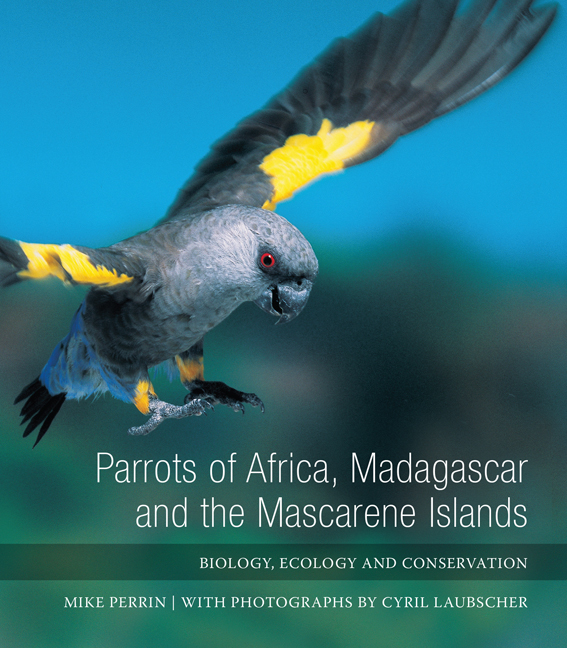Book contents
- Frontmatter
- Contents at a glance
- Contents
- Acknowledgements
- List of tables
- List of figures
- Abbreviations
- Chapter 1 Introduction
- Chapter 2 Conservation Biology
- Chapter 3 Systematics
- Chapter 4 Biogeography and Niche Separation
- Chapter 5 Intelligence, Communication and Behaviour
- Chapter 6 Breeding Biology
- Chapter 7 Diet and Metabolism
- Chapter 8 Case Study – The Cape Parrot
- Chapter 9 Trade in African parrots
- Chapter 10 African Parrot Conservation
- THE PARROT SPECIES OF AFRICA
- IUCN CATEGORIES
- Chapter 11 Long-Tailed and Fossil Parrots
- Chapter 12 True Parrots
- Chapter 13 Lovebirds
- Chapter 14 Field Techniques in Parrot Research
- Species lists
- Glossary
- Bibliography
- Index
Chapter 13 - Lovebirds
Published online by Cambridge University Press: 04 June 2019
- Frontmatter
- Contents at a glance
- Contents
- Acknowledgements
- List of tables
- List of figures
- Abbreviations
- Chapter 1 Introduction
- Chapter 2 Conservation Biology
- Chapter 3 Systematics
- Chapter 4 Biogeography and Niche Separation
- Chapter 5 Intelligence, Communication and Behaviour
- Chapter 6 Breeding Biology
- Chapter 7 Diet and Metabolism
- Chapter 8 Case Study – The Cape Parrot
- Chapter 9 Trade in African parrots
- Chapter 10 African Parrot Conservation
- THE PARROT SPECIES OF AFRICA
- IUCN CATEGORIES
- Chapter 11 Long-Tailed and Fossil Parrots
- Chapter 12 True Parrots
- Chapter 13 Lovebirds
- Chapter 14 Field Techniques in Parrot Research
- Species lists
- Glossary
- Bibliography
- Index
Summary
Order Psittaciformes (Parrots)
Family Psittaculidae (Parrots, cockatoos, lories and lorikeets)
Subfamily Agapornithidae (Lovebirds, hanging parrots and ‘mountain parakeets’)
Genus AGAPORNIS Selby
Lovebirds of the genus Agapornis are widely distributed throughout Africa. Each lovebird species is a small, green parrot endemic to the African mainland except for the Grey-headed Lovebird which is confined to Madagascar. They occupy various habitats, from semi-arid thornveld through Mopane Colophospermum mopane woodland to tropical forest. Seldom do more than two species co-occur although this happens in central Africa where the Red-faced Lovebird is sympatric with several other species. The small size of lovebirds parallels the parrotlets of South America, their form the fig parrots of Indonesia and their ecology with the grass parakeets of Australia. They are separated morphologically and ecologically from the larger African parrots which comprise two other size classes. The smaller parrots include the Brown-headed, Meyer's and Ruppell's parrots, while the larger species are exemplified by the African Grey Parrot and the Cape Parrot. Some lovebirds, like the Rosy-faced Lovebird of Namibia, feed mainly on fallen grass seeds and may compete with finches, mannikins and waxbills for food. Others, including the Black-winged Lovebird, are frugivorous and may share food resources with starlings, hornbills and fruit bats. The Black-winged Lovebird is a dietary specialist feeding almost entirely on figs. Typically, lovebirds have a characteristic colourful facial mask, and often a colourful rump with a recognisable tail pattern. Some species are monochromatic with no difference in colour patterns between the male and female, such as Fischer's Lovebird, while others are sexually dichromatic, as in the Red-faced Lovebird. There are basically two groups of lovebirds within the genus. The white-eye-ringed species (Black-masked A. personatus, Fischer's A. fischeri, Lilian's A. lilianae and Black-cheeked A. nigrigenis) are closely related, monochromatic, more social and probably derived from the species without white eye-rings (Grey-headed A. canus, Black-winged A. taranta, Red-faced A. pullarius and Swindern's A. swindernianus), which are dichromatic and less social. The Rosy-faced Lovebird A. roseicollis tends to be somewhat intermediate (see Chapter 3: Systematics).
- Type
- Chapter
- Information
- Parrots of Africa, Madagascar and the Mascarene IslandsBiology, Ecology and Conservation, pp. 455 - 518Publisher: Wits University PressPrint publication year: 2012



